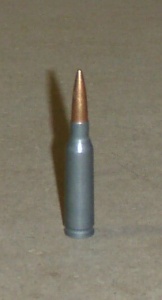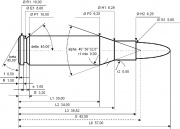Difference between revisions of "5.45x39mm"
(→Notes and Citations) |
m (1 revision) |
Revision as of 15:23, 15 March 2013
| 5.45x39mm M74 | ||||||||||
|---|---|---|---|---|---|---|---|---|---|---|

| ||||||||||
| The 5.45 Soviet cartridge. | ||||||||||
| Type | rifle | |||||||||
| Country of Origin | USSR | |||||||||
| Specifications | ||||||||||
| Case Type | Steel, rimless, bottleneck | |||||||||
| Bullet Ø | 5.680 mm (0.2236 in) | |||||||||
| Neck Ø | 6.248 mm (0.2460 in) | |||||||||
| Shoulder Ø | 7.290 mm (0.2870 in) | |||||||||
| Base Ø | 10.033 mm (0.3950 in) | |||||||||
| Rim Ø | 10.008 mm (0.3940 in) | |||||||||
| Rim Thickness | 1.372 mm (0.0540 in) | |||||||||
| Case Length | 39.624 mm (1.5600 in) | |||||||||
| Full Length | 56.388 mm (2.2200 in) | |||||||||
| Primer | Berdan, small rifle | |||||||||
| Production & Service | ||||||||||
| In Service | 1974-present | |||||||||
| Used By | Soviet Union/Russian Federation, former Soviet republics | |||||||||
| Wars | Afghan War (Soviet), Georgian Civil War, First Chechen War, Second Chechen War, Balkan Wars | |||||||||
| Ballistic Performance Sampling | ||||||||||
| ||||||||||
The Soviet 5.45x39mm round was introduced into service in 1974 for the AKS-74U and the AK-74 assault rifle. It gradually supplemented then largely replaced the 7.62x39mm round then in service.
Contents[hide] |
Design
The Russian military issue 5N7-specification 5.45 mm bullets are a somewhat complex full metal jacket design. The bullet's core consists mainly of a length of soft steel rod, cut to length during the manufacturing process to give the correct weight. There is a hollow air space ahead of the steel rod behind the bullet tip. The base of the bullet is tapered to reduce drag (a boat-tail bullet) and there is a small lead plug crimped in place in the base of the bullet. The lead plug, in combination with the air space at the point of the bullet, has the effect of moving the bullet's center of gravity to the rear; the hollow air space also makes the bullet's point prone to deformation when the bullet strikes anything solid, inducing yaw.
Wounding effects
Early ballistics tests done demonstrated a pronounced tumbling effect with high speed cameras.[1] Some Western authorities believed this bullet was designed to tumble in flesh to increase wounding potential.
At the time, it was believed that yawing and cavitation of projectiles was primarily responsible for tissue damage. Non-Soviet alarmists feared that this new cartridge had achieved wounding parity with the 5.56x45mm NATO round. To dispute this, Fackler conducted a study using live pigs and ballistic gelatin demonstrating that the 5.45 mm round does not reliably fragment or cause unusual amounts of tissue disruption. [2] Most organs and tissue were too flexible to be severely damaged by the temporary cavity effect caused by yaw and cavitation of a projectile. With the 5.45 mm bullet, tumbling produced a temporary cavity twice, at depths of 100 and 400 mm. This is comparable to modern 7.62x39mm ammunition and to (non-fragmenting) 5.56 mm ammunition. The average width of a human trunk is 400 mm.
Anti-armor effect
As body armor saw increasing use in Western military forces, bullet construction was changed several times to keep it up with improving means of ballistic protection. In 1987 a steel rod of original design 7N6 bullets was hardened to 60 HRC. In 1992 size of the steel penetrator was increased, and lead plug in front of it discarded (still there was some empty space under the jacket in the bullet's nose), this bullet designated as 7N10 "improved penetration". In 1994 the 7N10 design was improved by filling nasal empty space with lead again. At the impact at hard target soft lead is pressed sideways by following steel penetrator, its hydrostatic pressure tearing the jacket, so the penetrator goes in clear of jacket, being able to penetrate more. In 1998 a new design was introduced - a 7N22 armour-piercing bullet with sharp-pointed steel penetrator made of special steel, still with soft lead plug in the nose for jacket discarding. [3] A newest known design is 7N24 "super-armor-piercing" bullet with penetrator made of tungsten carbide, but due to higher cost it's doubtful that 7N24 would be fielded in large scale.
Specifications
(See also the table in the top right of the article)
- Bullet weight: 3.43 g (7N6), 3,61 g (7N10), 3,69 g (7N22), about 4 g (7N24), 5,15 g (7U1 subsonic for use with silencer)
- Muzzle velocity: 915 m/s (7N6?)
- Muzzle energy: 1,316 J (7N6?)
References
- ↑ Terminal ballistics of the Russian AK 74 assault rifle: Two wounded patients and experimental findings
- ↑ Wounding Potential of the AK-74 Assault Rifle
- ↑ Evolution of the 5,45 mm bullet
